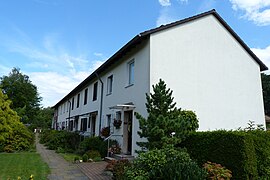Park settlement Kippekausen
The park settlement Kippekausen in Kippekausen was an infrastructure project in the time of the German economic miracle to create new living space for around 3,000 citizens.
history
The main initiator of the project called Demonstrative Program of the Federal Minister for Housing and the Minister for Reconstruction of North Rhine-Westphalia was Paul Lücke . From 1957 to 1965 he was Minister for Housing in Konrad Adenauer's cabinet and previously Chairman of the Committee for Reconstruction and Housing. The fact that Lücke lived in Bensberg and was always a directly elected member of the constituency of the Rheinisch-Bergischer Kreis in the Bundestag contributed to the choice of location .
The planned building area bordered in the west on the previous development of the Refrath district, in particular on the Schmillenberg settlement built in 1949 . In the west a piece of forest remained up to the Bensberger See . The symbolic foundation stone was laid in October 1959 by Peter Erkens , the North Rhine-Westphalian Minister for Reconstruction, in a separate monument on Burgplatz. The mammoth project was realized in three construction phases by the beginning of 1962 under the direction of Westaufbau GmbH . This resulted in 440 private homes and high-rise buildings with 405 rental apartments. Most of the homes are two-story row houses with a living space of around 90 square meters, there are also one-story bungalows on An der Wallburg street . There are rental apartments with one to five rooms, a good 50 percent are three-room apartments. The total construction costs including land acquisition amounted to almost 38 million DM .
A central district heating supply was set up to heat all buildings. To loosen up the development, a green corridor remained across the construction area, in which the remains of the Motte Kippekausen can still be found and only the tent church , a primary school and a daycare center were built.
The official topping-out ceremony was celebrated on September 1, 1961 in the presence of Federal Chancellor Adenauer, Federal Minister Lücke, Prime Minister of North Rhine-Westphalia Franz Meyers and the Bensberg Mayor Ulrich Müller-Frank. With the construction project, the number of six million new apartments in the Federal Republic of Germany had been exceeded. The house at Burgherrenweg 25 is the jubilee house. For the jubilee, a lettered bronze plaque was attached to the foundation stone memorial.
Most of the streets newly laid out for the development of the building area are reminiscent of the former high medieval castle complex with their names: Am Burgtor , An der Wallburg , Burgherrenweg , Burgplatz and Burgstraße .
The park settlement forms the largest built-up area in the Kippekausen district, which was created by the redistribution of the city districts in 1975 . As a result of the general decline in the number of inhabitants per household , the figure of 3,000 inhabitants propagated at the start of construction is no longer achieved; in the entire Kippekausen district in mid-2017, only 2,527 inhabitants lived in 1,256 households.
Trivia
One of the most prominent buyers of a bungalow was the athlete Manfred Germar . In November 2014, metal thieves stole the bronze plaque in memory of the six millionth apartment. The destroyed plaque was restored by the city and placed in its old location on May 28, 2015.
Individual evidence
- ^ Kippekausen - living on castle walls. Retrieved August 8, 2017 .
- ↑ a b Don't leave memories to metal thieves. Retrieved August 8, 2017 .
- ↑ a b c Parkiedlung Kippekausen A demonstrative building project by the Federal Minister for Housing , official project description of the Ministry, p. 11
- ^ Folk festival with the Chancellor. Retrieved August 8, 2017 .
- ^ Andree Schulte, Bergisch Gladbach, city history in street names , published by the Bergisch Gladbach city archive, volume 3, and by the Bergisches Geschichtsverein department Rhein-Berg e. V., Volume 11, Bergisch Gladbach 1995, pp. 336ff, ISBN 3-9804448-0-5
- ^ Statistics - City of Bergisch Gladbach. Retrieved August 8, 2017 .
literature
- Klaus Rieger: The park settlement Kippekausen . 1959 - 2019, the beginning of a model estate with the 6 millionth post-war apartment. Ed .: Bürger- und Heimatverein Refrath eV self-published, Bergisch Gladbach 2019.
Web links
- Film in the Neue Deutsche Wochenschau on September 8, 1961 (start at 1: 47.15). Retrieved August 8, 2017 .
Coordinates: 50 ° 57 '19.4 " N , 7 ° 7' 15.4" E




